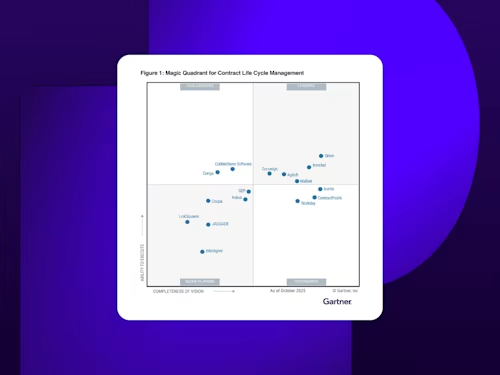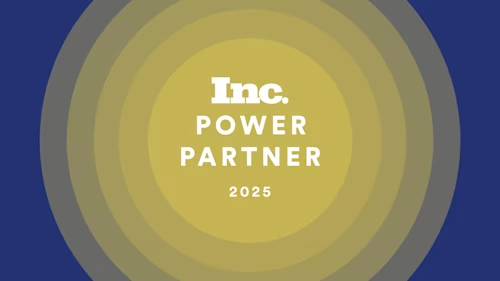
Six Ways Digital Contract Technologies Create Business Value
As the scope of modern agreement tools expands, it’s time to reconsider their dollars-and-cents impact.
Table of contents

Electronic signature technology is a clear improvement over traditional ink-and-paper signatures, offering a range of important workflow improvements and cost savings. On average, electronic signature adoption alone saves a modern organization around $36 per agreement. However, electronic signature technology isn’t the only way to create business value with digital contract technologies.
Modern businesses are accelerating their digital transformations and expanding their suite of agreement tools to prepare documents, negotiate contract details, act on the terms and manage agreement portfolios. A comprehensive, interconnected agreement workflow creates additional business value in entirely new ways. Through automation and integration with other business systems, a robust system of agreement can deliver value as much as four times higher than eSignature alone.
As the scope of modern agreement tools expands, it’s time to reconsider their dollars-and-cents impact. In this blog post, we’ll examine six business drivers that impact revenue at either the transactional or platform level. For a deeper dive into these business drivers, download the free Recalculating the Value of a Modern System of Agreement ebook.

Transactional improvements
The most straightforward impacts of the modern agreement process are the transactional improvements. These benefits affect the process of completing individual agreements. Here’s more information about the three primary transaction-related business drivers:
Time to revenue
When agreements move faster, the revenue from those deals can be recognized sooner. A less complicated agreement process also translates into a higher completion rate, which means more deals get done. A streamlined system of agreement uses automation and integration to reduce the number of manual steps in the process, which also eliminates the room for error and delay.
Moving at the speed of digital business accelerates the timelines for all organizational initiatives—revenue generation, hiring, product releases, etc. By reducing turnaround time for all these agreements, a company spends less time waiting and gets more value out of critical business projects.
Workforce productivity
Electronic signature alone delivers significant employee productivity savings, but the value increases dramatically when agreement steps before and after the signature are digitized and connected. More efficient agreement tools allow every employee to be more productive. The best way to improve efficiency is to utilize an agreement platform that connects the entire end-to-end process. This setup allows for increased information sharing and opportunities for automation.
It’s not enough to simply complete agreements faster, it’s also critical to assess the content of those agreements and make sure that you’re creating better agreements. Manual data entry in an agreement process wastes time and increases the opportunity for error. For example, copy/pasting customer information from a CRM into a contract can result in a range of problems. Those manual processes can be replaced with a digital system that automatically pulls data from the CRM record, improving speed and accuracy. A modern system of agreement will improve clarity, reduce errors, specify enforceability of terms and maximize the value for all parties.
Hard costs
Docusign research found that every time a business signed an agreement electronically, it saved around $6 in printing, distributing and storage costs alone. Depending on the legacy systems in place for your business, a CLM tool with AI-assisted automated analysis of contracts can also reduce or eliminate hard costs associated with payments to outside consultants to manually review contract clauses. For a business that processes tens or hundreds of thousands of agreements a year, those costs can add up very quickly.
Platform improvements
Platform benefits are broader in scope than individual transactions, creating an end-to-end agreement workflow with efficiency gains at every step. These benefits reduce operational and compliance risks by improving contract quality and a company’s ability to execute and manage agreements more accurately. Here’s an overview of three primary platform improvements:
Contract value leakage
Over time, contracts fail to reach their full potential and might even lose value. The difference between the potential value of an agreement and value that is actually realized is the value leakage. Leakage can happen before a contract is signed (signing suboptimal contracts) or after it is signed (poor understanding of agreement contents and inability to execute the terms) and is often the single biggest opportunity for a business to gain value from agreements.
AI-powered analysis of contracts during the negotiation process can confirm that contract language meets your organization’s business, legal and compliance requirements before you sign. Similar advanced search and analysis of existing contracts can help spot obligations and opportunities over time, such as additional pricing discounts based on contract milestones. A modern system of agreement will standardize agreement language, analyze existing (or new) agreements quickly and connect critical business tools to take action on contract terms.
Compliance
For all businesses, regulations put controls around commercial activities. While compliance efforts can be costly, the risks of noncompliance are even more expensive. Investing in compliance activities such as audits, technologies and training creates value by avoiding noncompliance penalties related to data protection regulations. Creating templates and standard contract clauses that can be used in a variety of scenarios maximizes the legal team’s time and minimizes room for errors to ensure compliance.
Ease of doing business
There’s inherent value in making agreements easy. Delivering a superior agreement experience is a critical tactic to improve business relationships with all internal and external parties. Forcing people through time-consuming manual agreements decreases their satisfaction and signals that your company isn’t operating at modern speed.
Today’s consumers are seeing streamlined agreements in other parts of their lives and they expect every business transaction to avoid the painful processes of printing, signing, scanning, faxing and mailing paper copies of documents. To some degree, employees have a similar expectation. Simplifying employee agreements is an easy way to increase productivity and reduce the cost of turnover from dissatisfied employees. Finally, from a sustainability perspective, digital agreements allow an organization to do business while being easy on the environment.
To learn more about how these six value drivers can create more value for your business, download the free Recalculating the Value of a Modern System of Agreement ebook.
Related posts
Docusign IAM is the agreement platform your business needs



